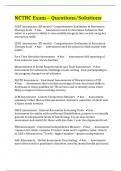Exam (elaborations)
Ch 43 Care of the Patient with an Integumentary Disorder Questions with 100% Actual correct answers | verified | latest update | Graded A+ | Already Passed | Complete Solution
- Course
- Institution
Ch 43 Care of the Patient with an Integumentary Disorder Questions with 100% Actual correct answers | verified | latest update | Graded A+ | Already Passed | Complete Solution
[Show more]




